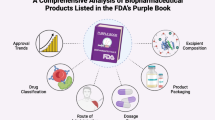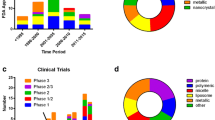Abstract
Pentostatin, an unusual nucleoside of natural origin, has been used for the treatment of hairy cell leukemia, as an immunosuppressant agent, and as an inhibitor of adenosine deaminase. The studies of the physicochemical properties and solution stability of pentostatin (1) are important to the development of a parenteral formulation for extensive preclinical and clinical testing. Pentostatin displayed apparent pK a values at 25 ± 0.1°C and ionic strength of 0.15 M of 2.03 ± 0.03 and 5.57 ± 0.14 (spectrophotometric) and 5.50 ± 0.02 (potentiometric) for N1 and the amidine nitrogen in the seven-membered ring, respectively, which are the most likely protonation sites. The rates of degradation of pentostatin were determined as a function of pH, buffer concentration, and temperature. In the pH range 1.0–4.0, pentostatin undergoes acid-catalyzed glycosidic cleavage leading to the formation of the base compound, 2, and 2-deoxyribose. A carbonium ion mechanism in which C–N bond cleavage was the rate-determining step was consistent with the data. In the pH range 6.5–10.5, the imine bond at C5 position in pentostatin is hydrolyzed to form the corresponding formamide. Pentostatin hydrolysis in this pH range was independent of pH. At pH >11, pentostatin decomposes to nonchromophoric products probably through multiple-step base-catalyzed hydrolytic mechanisms. Pentostatin appears to be quite stable after reconstitution of a lyophilized experimental dosage form. Care must be taken if pentostatin is extensively diluted with 5% dextrose in water, as pentostatin stability is compromised at pH values less than 5.
Similar content being viewed by others
REFERENCES
R. P. Agarwal, T. Spector, and R. E. Parks, Jr. Biochem. Pharmacol. 26:359–367 (1977).
W. M. Shannon and F. M. Schabel, Jr. Pharmacol. Ther. 11:263–390 (1980).
P. W. K. Woo, H. W. Dion, S. M. Lange, L. F. Dahl, and L. J. Durham. J. Heterocycl. Chem. 11:641–643 (1974).
D. C. Baker, S. R. Putt, and H. D. Hollis Showalter. J. Heterocycl. Chem. 20:629–634 (1983).
E. Chan, S. R. Putt, H. D. Hollis Showalter, and D. C. Baker. J. Org. Chem. 47:3457–3464 (1982).
S. R. Putt and D. C. Baker. J. Am. Chem. Soc. 101:6127–6128 (1979).
E. H. Kraut, B. A. Bouroncle, and M. R. Grever. Blood 68:1119–1122 (1986).
A. Albert and E. D. Serjeant. In Ionization Constant of Acids and Bases, John Wiley & Sons, New York, 1962, pp. 9–22, 44–59.
B. D. Anderson, M. B. Wygant, T. X. Xiang, W. A. Waugh, and V. J. Stella. Int. J. Pharm. 45:27–37 (1988).
B. I. Perillo, B. Fernandez, and S. Lamdan. J.C.S. Perkin II:2068–2072 (1977).
E. R. Garrett and P. J. Mehta. J. Am. Chem. Soc. 94:8532–8541 (1972).
E. R. Garrett and P. J. Mehta. J. Am. Chem. Soc. 94:8542–8547 (1972).
J. L. York. J. Org. Chem. 46:2171–2173 (1981).
R. Th. Morrison and R. N. Boyd, Organic Chemistry, 3rd ed., Allyn and Bacon, 1973.
W. Pigman, The Carbohydrates, Chemistry, Biochemistry, Physiology. Academic Press, New York, 1957.
E. Breitmaier and W. Voelter. Monographs in Modern Chemistry, Vol. 5, Weinheim, Bergatr, 1974.
G. W. Kenner. In G. E. Wolsteholme and C. M. O'Connor (eds.), The Chemistry and Biology of Purines, Little, Brown, Boston, 1957, p. 312.
J. A. Zoltewicz, D. F. Clark, T. W. Sharpless, and G. Grahe. J. Am. Chem. Soc. 92:1741–1750 (1970).
J. A. Zoltewicz and D. F. Clark. J. Org. Chem. 37:1193–1197 (1972).
F. L. Boschke, W. Fresenius, J. F. K. Huber, E. Pungor, G. A. Rechnitz, W. Simon, and S. Th. West. Tables of Spectral Data for Structure Determination of Organic Compounds, Springer-Verlag, New York, 1983, P.H.-155.
R. H. DeWolfe and R. M. Roberts. J. Am. Chem. Soc. 75:2942–2947 (1953).
R. H. DeWolfe. In S. Patai (ed.), The Chemistry of Amidines and Imidates, John Wiley & Sons, 1975, Chap 8, pp. 349–384.
Author information
Authors and Affiliations
Rights and permissions
About this article
Cite this article
Al-Razzak, L.A., Benedetti, A.E., Waugh, W.N. et al. Chemical Stability of Pentostatin (NSC-218321), a Cytotoxic and Immunosuppressant Agent. Pharm Res 7, 452–460 (1990). https://doi.org/10.1023/A:1015852329748
Issue Date:
DOI: https://doi.org/10.1023/A:1015852329748




